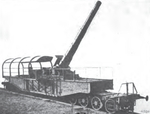24 cm Schnelladekanone Theodor Karl Railway Gun
| Country of Origin | Germany |
| Type | Railway Gun |
| Caliber | 238.000 mm |
| Length | 8.866 m |
| Barrel Length | 18.450 m |
| Weight | 110200.000 kg |
| Ammunition Weight | 148.50 kg |
| Range | 26.000 km |
| Muzzle Velocity | 810 m/s |
Contributor: C. Peter Chen
ww2dbaseThe 24 cm Schnelladekanone Theodor Karl railway guns, also known as 20 cm SK L/40, were originally naval guns of the Kaiser Friedrich III-class and Wittelsbach-class battleships. They were built by the German armament manufacturer Krupp. They were unmounted from the warships beginning in Feb 1915 by the German Empire and were adopted for combat on the ground in various roles. Eight of them were installed as coastal guns at Sylt and Norderney in northern Germany, while the other eighteen were prepared as portable heavy guns for fighting at the western front. The Germany Army quickly realized that the lengthy time required to set up such guns in the battlefield was unacceptable, thus on 1 Jul 1916 it was decided that they were instead be mounted as railway guns. Four guns were tested at the Krupp Proving Grounds in Meppen, Germany in Dec 1916. After a series of adjustments, these railway guns were commissioned into service and saw action on both Eastern and Western Fronts of WW1. After the end of WW1, Belgium captured and kept three of them, Germany was allowed to retain four as defensive guns at Wilhelmshaven, while the remaining 19 guns were destroyed per orders of the victors. The Belgians deployed the three guns as stationary coastal defense guns.As Germany geared for a potential future war in the 1930s, Krupp was given permission to rebuild three of the four Wilhelmshaven guns as railway guns. They were given turntables that made use of circular tracks for 360-degree traverse. They could be loaded only at no elevation, thus they must be re-aimed after each shot. Krupp delivered all three guns in 1937. All three participated in the early phases of the French campaign in 1940, and a fourth one was acquired when Germany captured the only other surviving sister gun that was being used by Belgium. All four guns were then assigned to Artillerie-Batterie (Eisenbahn) 664 and Artillerie-Batterie (Eisenbahn) 674 (664th and 674th Railway Gun Batteries) in southwestern France near Hendaye and Saint-Jean-de-Luz, near the Spanish border. On 1 Sep 1944, all four guns were withdrawn to Germany. No further record existed for these four railway guns.
Source: Wikipedia
ww2dbaseLast Major Revision: Dec 2010
Photographs
 |  |
Please consider supporting us on Patreon. Even $1 per month will go a long way! Thank you. Please help us spread the word: Stay updated with WW2DB: |
Search WW2DB

News
- » Wreck of Teruzuki Found (27 Jul 2025)
- » USS Orlean's Bow Found (22 Jul 2025)
- » The Emperor of Japan Planned to Honor WW2-era Japanese POWs in Mongolia (4 Jul 2025)
- » US State Lawmaker John Winter Caught Using Racial Slur "Jap" and Apologized (11 Jun 2025)
- » US Government Plans to Purge WW2 Information (17 Mar 2025)
- » See all news
24 cm Schnelladekanone Theodor Karl Railway Gun Photo Gallery
 |
Current Site Statistics
- » 1,181 biographies
- » 337 events
- » 45,132 timeline entries
- » 1,249 ships
- » 350 aircraft models
- » 207 vehicle models
- » 376 weapon models
- » 123 historical documents
- » 261 facilities
- » 470 book reviews
- » 28,426 photos
- » 365 maps
Famous WW2 Quote
"An appeaser is one who feeds a crocodile, hoping it will eat him last."Winston Churchill
Support Us
Please consider supporting us on Patreon. Even $1 a month will go a long way. Thank you!
Or, please support us by purchasing some WW2DB merchandise at TeeSpring, Thank you!